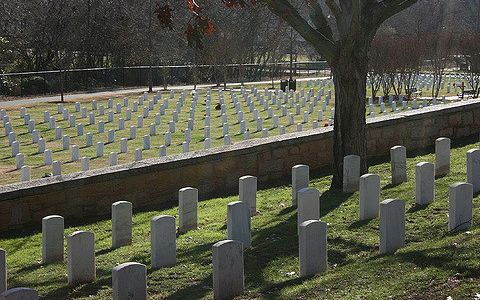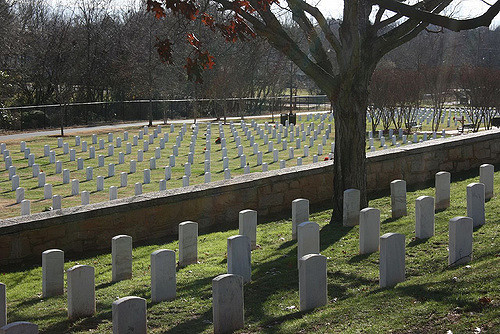More than 150 years ago, men fought and died in mostly small but still savage Civil War battles in North Carolina that ranged from the western mountains to the Outer Banks.
Tourists have been more likely to visit Fort Fisher, the important coastal fort on Kure Beach;Bentonville Battlefield in Johnston County, where the state’s largest Civil War battle took place; and Bennett Place in Durham, site of the largest surrender of Confederate forces in the war.
But North Carolina is also home to hundreds of other lesser-known places that paint a grittier and less romantic side of the Civil War, which some Southerners still prefer to call “The War Between the States.”
“The war has been boiled down to big places, big battles and big events,” said Ernest Dollar, director of the City of Raleigh Museum and a Civil War historian. “We get sort of this American story of the Civil War.
“By visiting a lot of the lesser-visited places in North Carolina, you get to see a different side of this big story. This allows you to get into the complexities of the Civil War.”
One of the less frequently visited Civil War sites is the Monroe’s Crossroads battlefield in Hoke County on what’s now Fort Bragg. The battlefield’s location on an active military base, and its proximity to live firing ranges means that tours are by appointment only.
Jonathan Schleier, base archaeologist at Fort Bragg, estimates he does 12 to 24 tours a year.
Signs along the battlefield site warn people about the potential for unexploded ammunition. Artillery fire can be heard in the background as Schleier talks about the battle that took place there on March 10, 1865.
Monroe’s Crossroads was a relatively small battle by Civil War standards, involving around 5,000 soldiers and resulting in fewer than 300 casualties. But it’s rife with stories about over-the-top characters, odd moments and lessons that still are of interest today.
The Civil War was nearing the end in March 1865 when Confederate cavalry units led by Lt. Gen. Wade Hampton attempted to slow down the Union cavalry forces that were heading toward Fayetteville.
Brig. Gen. Judson Kilpatrick, the Union commander, had his men stop for the night at a farmhouse at Monroe’s Crossroads. Kilpatrick, a recent widower, might have had his attention distracted because “he’s kind of on a gentleman’s tour of the South,” Schleier said.
“He goes with his girlfriend into the cabin and shacks up there,” Schleier said. “He doesn’t check his under-officer’s preparations, so he doesn’t catch the gaffe of not putting any sentries on the west side of the camp.”
Confederate forces, who had a secondary mission of trying to capture Kilpatrick, attacked through an undefended position to surprise the sleeping Union forces.
A nightshirt-clad Kilpatrick was on the porch of the house when he was surprised by a Confederate soldier who asked him where the Union general was. Kilpatrick pointed to a fleeing uniformed officer and, after the Confederate left, fled into the woods.
“That’s where the battle gets its other name from: Kilpatrick’s Shirttail Skedaddle,” Schleier said. “A slightly derisive dig at Kilpatrick for his flight in his pajamas.”
Confederate soldiers assumed that Kilpatrick’s girlfriend was the lady of the house. She played along with them, so the house wasn’t searched, saving the Union officers who were trapped inside.
The Confederate advance stalled when the hungry soldiers stopped to loot the campsite abandoned by the fleeing Federals. The halt gave the Union soldiers time to regroup and counterattack. The Confederates eventually retreated when Union reinforcements were on the way.
The Army has preserved the site, erected a monument honoring both sides and marked where the battle’s dead are buried.
To arrange a tour of Monroe’s Crossroads, email jonathan.r.schleier.ctr@mail.mil or call 910-908-4283.
SALISBURY NATIONAL CEMETERY
Salisbury National Cemetery is the final resting place for thousands of Union soldiers who were buried in mass graves at the Confederate prison camp. Salisbury prison was intended to hold 2,500 prisoners but wound up holding more than 10,000 Union soldiers. After the war, the cemetery was established on the prison site. “It shows how sad, ugly and sickening that war can be that these men suffered so greatly in these prisons,” said Ernest Dollar, a Civil War historian. “It puts a face on war that is real.” It wasn’t always grim as one of the earliest-known drawings of people playing baseball shows a game involving Union prisoners at the camp.
PORT O’ PLYMOUTH MUSEUM
The Port o’ Plymouth Museum may be small, but it has a lot to tell visitors about the Civil War. Located in a historic train depot, the museum goes into the history of the 1864 Battle of Plymouth and the pivotal role played by the CSS Albemarle, an ironclad ship that terrorized Union naval forces and briefly allowed the Confederates to recapture the port town. It took a daring naval raid to sink the ship, which made it possible for the Union to take back Plymouth. A fully-operable replica of the Albemarle is docked by the museum and takes to the water each year on the last weekend of April. http://bit.ly/28Oz03K
NEW BERN BATTLEFIELD PARK
New Bern Battlefield Park looks much like it was on March 14, 1862, when more than 15,000 Union and Confederate troops fought in a battle that would determine who controlled the important nearby city of “New Berne.” The Battlefield Park includes more than 30 acres of the original battlefield and is in near pristine condition, unlike many sites in other states that have been fighting against encroaching development. Visitors can see the “redans,” or trenches, that the soldiers dug and fought from more than 150 years ago. New historical markers will be placed on the site later this year.http://bit.ly/28QXYA9
ARSENAL PARK, FAYETTEVILLE
Union General William T. Sherman burned far less in North Carolina than in South Carolina or Georgia, but one of the structures that didn’t survive in the Tarheel State was the former U.S. Arsenal in Fayetteville. In April 1861, state militia seized the arsenal a month before North Carolina officially seceded from the Union. The state later turned it over to the Confederate States of America, which used it to produce weapons and ammunition. When Sherman occupied Fayetteville in March 1865, he briefly used the arsenal as his headquarters before ordering his men to destroy the site. The massive brick-and-wood structure had become a source of civic pride, and its destruction upset the community. The Museum of the Cape Fear has preserved the remains, installed historical markers and erected a steel semblance of one of the arsenal’s towers. http://1.usa.gov/1SOxGgy
THOMAS’S LEGION, CHEROKEE AND WAYNESVILLE
William Holland Thomas was the only white man to serve as a Cherokee chief, and he formed a Confederate Army unit of Native Americans and mountaineers that came to be known as “Thomas’s Legion.” The legion squared off against the pro-Unionist guerrilla forces in the Western North Carolina mountains. His men fought in the May 1865 Battle of Waynesville, a Confederate victory that some have said saw the last shots fired east of the Mississippi River in the Civil War. “Thomas’s Legion is a great example of trying to understand the complexities of fighting for the Confederacy,” Dollar said. “Why did these Native Americans in the mountains of North Carolina choose to fight for the Southern cause? This brings up a lot of the questions about the appeal of the Confederate cause for Native Americans and white Americans.” The Museum of the Cherokee Indian contains an exhibit on the legion, including its battle flag, and a state highway historical marker in Cherokee commemorates the legion. Civil War Trails markers in Waynesville detail the battle and Thomas’ final resting place. Cherokee: http://bit.ly/28Sk7Pj; Waynesville:http://bit.ly/28YLDr8
SHELTON LAUREL MASSACRE, MARSHALL
One of the sources for Charles Frazier’s novel “Cold Mountain” came from the 1863 execution of 13 suspected Unionists in Madison County. Unionists had raided the town of Marshall after claiming that Confederate authorities had denied them provisions. Confederate soldiers went into the Shelton Laurel area and rounded up 13 males, as young as age 13, and executed them. Within days of the killings, Gov. Zebulon Vance condemned them but no one was ever prosecuted. “It shows that North Carolina was not united in the Southern cause,” Dollar said. “It shows you how brutal the war could be on the neighborhood level.” Visitors can see the massacre site at Shelton Laurel and tour Marshall, where historical markers talk about the massacre and the divided loyalties of the people living in the area. Shelton Laurel: http://bit.ly/28QjHaH; Marshall: http://bit.ly/28OrmF5




